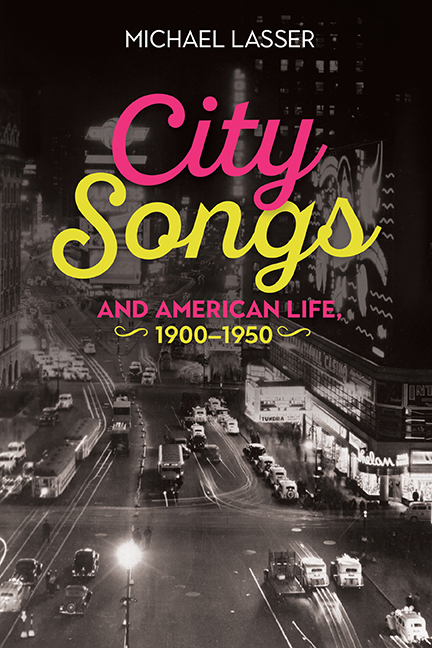Book contents
- Frontmatter
- Dedication
- Epigraph
- Contents
- Notes to the Reader
- Introduction: Encountering the City
- 1 The City's Clangor
- 2 Broadway's Melody
- 3 Harlem's Renaissance
- 4 Recordings, Radio, and Talkies
- 5 Starting the Century
- 6 The Flapper and the Jazz Age
- 7 The Great Depression
- 8 World War II
- Afterword
- Notes
- Bibliography
- Miscellaneous Endmatter
7 - The Great Depression
Published online by Cambridge University Press: 31 August 2019
- Frontmatter
- Dedication
- Epigraph
- Contents
- Notes to the Reader
- Introduction: Encountering the City
- 1 The City's Clangor
- 2 Broadway's Melody
- 3 Harlem's Renaissance
- 4 Recordings, Radio, and Talkies
- 5 Starting the Century
- 6 The Flapper and the Jazz Age
- 7 The Great Depression
- 8 World War II
- Afterword
- Notes
- Bibliography
- Miscellaneous Endmatter
Summary
The stock market crashed on October 29, 1929, and the flapper vanished faster than her sheik could swallow a goldfish. In 1925, Ray Henderson, Sam M. Lewis, and Joe Young had written “Five Foot Two, Eyes of Blue.” Three years later Cole Porter replaced “Let's Misbehave” with the equally naughty “Let's Do It.” By 1930, however, Ira Gershwin had spun out a plaintive lyric to “But Not for Me,” (George Gershwin and Ira Gershwin, Girl Crazy, 1930), Al Dubin wrote the lachrymose “Dancing with Tears in My Eyes” (Joe Burke and Al Dubin, 1930), and Leo Robin wrote the self-pitying “Prisoner of Love” (Russ Columbo, Clarence Gaskill, and Leo Robin, 1931). The characteristic ballads of the Depression tell a much different story than do the lighter-than-air love songs of the twenties, but despite what Peter Flynn calls their “forlorn escapism,” they ensured the survival of an urban sensibility for at least another decade. Woody Guthrie and the Almanac Singers were out on the road, singing labor songs and helping factory workers organize, but most Americans in big cities and small towns alike continued to embrace Tin Pan Alley and Broadway songs that rose, at least figuratively, from the hard pavements of New York City. It was a different kind of urbanity. In 1928, Milton Ager and Jack Yellen wrote the happy-go-lucky “Happy Days Are Here Again,” for a scene in an early talkie that depicted soldiers celebrating the end of World War I. But no one performed it until Black Thursday, when jeering listeners at New York's Hotel Pennsylvania belted it out along with George Olsen's Orchestra to transform it into an ironic Depression anthem, the other side of the same coin as a song such as Jay Gorney and E. Y. Harburg's “Brother, Can You Spare a Dime?”
Broadway mounted 233 productions, musical and otherwise, during the 1929–30 season. The next year, the number dropped to 187. The Broadway historian Robert Rusie observes that “the talent that Hollywood absorbed from Broadway was in the vicinity of 75%. By 1939, there were only 98 new openings. Things were even tougher for vaudeville. In 1925, vaudeville circuits controlled 1500 theaters. By 1930, only 300 remained and most of them were sharing performance time with movies.”
- Type
- Chapter
- Information
- City Songs and American Life, 1900–1950 , pp. 198 - 231Publisher: Boydell & BrewerPrint publication year: 2019



